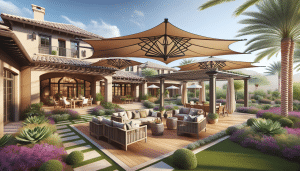Shade sails, with their simple yet effective design, have a rich history that dates back centuries. From their ancient origins to their modern evolution, these versatile structures have provided shade and shelter to people across different cultures and time periods. In this article, we’ll explore the fascinating history and evolution of shade sails, tracing their journey from the past to the present.
Contents
Ancient Origins
1. Egyptian Beginnings
The concept of using fabric for shade can be traced back to ancient Egypt. Egyptians used large pieces of fabric or palm leaves to create shade and shelter in the scorching desert heat.
2. Greek and Roman Influence
In ancient Greece and Rome, the use of shade was an integral part of architecture and outdoor living. Large cloth canopies and awnings were commonly employed to provide shade in public spaces, theaters, and even private residences.
Medieval and Renaissance Periods
1. Medieval European Awning
During the Middle Ages in Europe, awnings made of canvas or cloth were used for shade in markets and outdoor gatherings. These awnings were often supported by wooden or metal frames.
2. Renaissance Revival
In the Renaissance period, there was a revival of interest in outdoor living and leisure. Elaborate shade structures, resembling the sails of ships, were created for gardens and outdoor events.
Modern Era
1. Tensile Structures
The 20th century saw significant advancements in tensile architecture, which involves the use of flexible membrane materials to create innovative structures. This period marked the beginning of what we now recognize as shade sails.
2. Architectural Innovation
The development of new materials and technology in the mid-20th century allowed for the creation of shade sails with increased durability and UV protection. These sails were used in various architectural and outdoor design projects.
Contemporary Shade Sails
1. Versatile Design
Today, shade sails come in a wide range of shapes, sizes, and materials. They are used in residential, commercial, and public spaces to provide shade, enhance aesthetics, and create functional outdoor areas.
2. Customization
Modern shade sails offer opportunities for customization, including choosing colors, patterns, and sizes to match specific design preferences and purposes.
3. Sustainability
Sustainable and eco-friendly materials are increasingly being used in the production of shade sails, aligning with contemporary environmental concerns.
Conclusion
The history and evolution of shade sails reveal their enduring appeal and practicality. From their humble beginnings in ancient civilizations to their current role in contemporary architecture and design, shade sails have come a long way. Today, they continue to provide shade, style, and functionality in outdoor spaces, offering a timeless solution for staying cool and protected from the sun’s rays.
At Arizona Shade Sails, we embrace the legacy of shade sails and offer modern solutions for your outdoor needs. Contact us at (480) 418-8438 or visit our website at shadesailsaz.com to explore how shade sails can enhance your outdoor space while honoring their historical roots.




